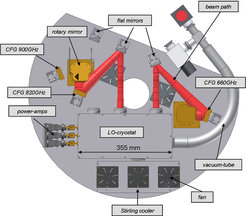Local Oscillator

CAD-drawing of the CHAMP+ LO-unit. To cover the wide tuning range of the 350 μm channel two separate LOchains are necessary. In the figure only the beam path of the lower-frequency LO chain is shown. Rotating the “flat 350 μm mirror” by 90° clockwise switches between the two high-frequency chains. Tilting the three flat-mirrors and the CFGs ensures proper alignment. All three LO-chains are operated cold (< 120 K) to improve the performance as well as the lifetime of the multipliers. Cooling is provided by a commercial Stirling-cooler with ≈ 9 W cooling power at 80 K. The warm air from the Stirling-cooler is directed towards the dewar windows to prevent condensation.
The design of the LO chains follows the experience gained during the development of the Herschel/HIFI Local Oscillators. A synthesizer signal in the range of 11 – 18 GHz is first multiplied by a factor of 6 to generate 1 mW RF power at the input of the W-band power amplifier provided by JPL. The amplifier produces up to 250 mW of RF signal power and drives the cascaded tuner-less frequency multiplier stages which are cooled to 120K. In the 450 μm channel a doubler/doubler/doubler combination is used, whereas a doubler/doubler/tripler cascade generates the output in the 350 μm channel. To cover the wide tuning range of the 350 μm channel, two LO-chains are necessary. A rotary mirror selects between these two LO signals.
